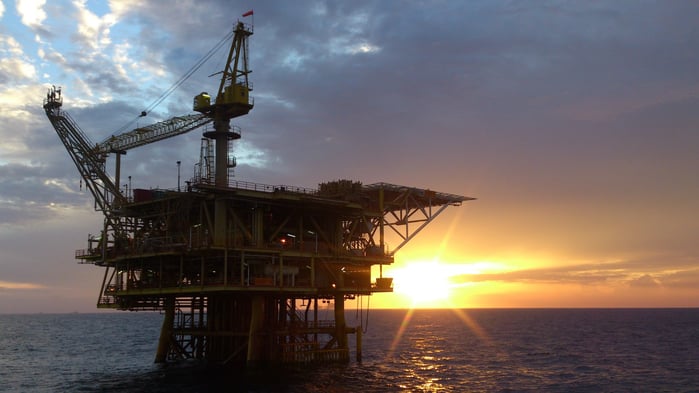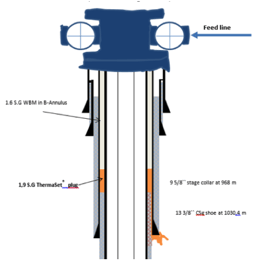
We are situated on a platform in the Dutch sector of the North Sea. During pressure bleed-off of the annulus, both gas and oil-like fluid has been observed. The situation is unwanted and it can potentially escalate without remedial work. We are called out to reestablish the integrity of the oil producing well.
The last couple of months we have covered several topics within the Well integrity, and I believe around ten articles have been elaborating around subjects related to sustained casing pressure (SCP).
This is one of the articles which you also can read to learn more: 5 keys to the successful remediation of sustained annular pressure
Today I'll like to share with you a case history within a SCP application.
Several of our articles have focused on the importance of doing proper planning before mobilization. I hope this story will give you good insight into how we execute all stages in operation from designing a suitable solution, recipe design, execution and to end of well reporting.
The Challenge
Let's begin with describing the challenge. We are offshore on a fixed platform in the Dutch sector of the North Sea. An oil producer is using gas lift to enable production and suffers from SCP in the B-annulus. The pressure builds up to 57 bars. Both gas and oil like fluid are observed during pressure bleed-off.
Well-survey has indicated that the pressure-build up is caused by communication with the reservoir through a channel in the cement behind the 9-5/8" casing. Based on the fluid sample that had been recovered from the B-annulus, it is suspected to be a communication with the reservoir below the 13-3/8" shoe at 1030mMD, TOC is at 968mMD and the well inclination at this point is around 44 degrees. The original annular fluid was 1,6 SG WBM. Pressure and injection tests indicated no communication with A-Annulus. The client executed an injectivity test one month before operation start. At 104 bars, they could measure a leak rate at 3.52 l/ hr.
There is no doubt ThermaSet can seal the leak, if we just get it to the right place. To get sufficient intact volume of ThermaSet to the critical place in an effective enough way to seal the leak, is the real challenge in this case.
More to read: Effective ways of reducing well integrity problems and our case Sustained casing pressure.
The Objective
Our objective was to plug the suspected micro channel in the cement behind the casing and disconnect the B-annulus from the source of hydrocarbon, thus stop pressure from building up in B-annulus.
- A typical scope for us in these type of operation is as follows:
- Engineering of solution, lab testing, operational planning
- Provision of personnel - Supervisor and field engineers
- Provision of equipment- Field laboratory, Pumps and batch mixer
- Material - Resin, additives, and cleaner
The Plan
After designing the solution and agreeing with the customer, we optimized a recipe for this application as well as performed lab testing for verification and contamination tests. A detailed program was created together with our client. The plan was in principle to evacuate fluid from the annulus to make space for the ThermaSet resin, let the ThermaSet sink down by gravity to TOC (it is designed heavier than the annular fluid), then apply pressure and squeeze ThermaSet into the cracks or microannulus in the cement and seal the annulus. The following was our plan for execution:
 Prepare/mix 3 m3, 1,9 SG ThermaSet pill with 6 hours gel time at 50oC (temperature at the TOC). ThermaSet® was to be transferred to the batch mixer, the Micromax (weighing agent) mixed in, before the Curing Initiator was added to start the curing reaction.
Prepare/mix 3 m3, 1,9 SG ThermaSet pill with 6 hours gel time at 50oC (temperature at the TOC). ThermaSet® was to be transferred to the batch mixer, the Micromax (weighing agent) mixed in, before the Curing Initiator was added to start the curing reaction. - Pump the pill into the B-Annulus with the help of centrifugal pump
- The experimentally defined settling time of 1.9 SG ThermaSet® pill through 1.6 SG water-based fluid was approximately 2 hours.
- Applied above 100 Bar squeeze pressure to squeeze maximum volume of the pill into the channel. As per job program, the surface squeeze pressure was kept ~ 100Bar till curing of the pill (>12 hours).
The job and Result
The operation was performed in accordance with the plan. We successfully Inflow tested the B-Annulus. There was no flow or pressure build-up on B-Annulus. We could not get a good pressure test at 135 Bar, because of communication between B and C annuli. However, based on good inflow test, the job was declared a success.
More to read: Dealing with micro-annuli in casing cement
Lessons Learned and takeaways
It is important to verify injectivity before an operation. If injectivity is high enough to bullhead the resin in, we are fine. If not, a plan to evacuate fluid from the annulus must be made to allow the planned volume of resin to enter annulus. Verification of actual fluid level in annulus can easily be done with a eco meter. All this can be done prior to mobilizing.
- Verification by Wellcem that the correct type of mixing and pumping equipment is planned to be supplied by the pumping contractor, can be useful.
- During pressure testing, make sure there is no leakage to another annulus, e.g., B to C
- The optimized recipe could penetrate deep into micro-annuli, cure and seal off any cracks
The well was put back on full production only days after the resin pill was pumped. By remediation of the leakage by means of resin, the operator saved both time and money.
Sustained casing pressure or annulus pressure build-up can eventually force you to shut down the production. The consequences are loss or delay in production which can be very costly. Instead this simple and lean operation with limited numbers of personnel and a small equipment footprint was performed successfully in a few days.



